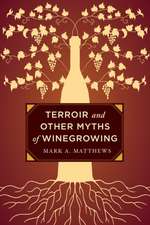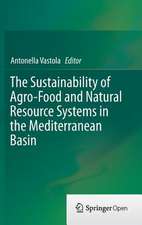Quality Assurance in Tropical Fruit Processing: Springer Lab Manuals
Autor Ahmed Askar, Hans Treptowen Limba Engleză Paperback – 15 dec 2011
Din seria Springer Lab Manuals
-
 Preț: 385.84 lei
Preț: 385.84 lei -
 Preț: 362.59 lei
Preț: 362.59 lei - 18%
 Preț: 973.69 lei
Preț: 973.69 lei - 15%
 Preț: 695.85 lei
Preț: 695.85 lei - 18%
 Preț: 997.40 lei
Preț: 997.40 lei -
 Preț: 382.18 lei
Preț: 382.18 lei - 24%
 Preț: 1045.08 lei
Preț: 1045.08 lei - 15%
 Preț: 641.20 lei
Preț: 641.20 lei - 18%
 Preț: 939.33 lei
Preț: 939.33 lei -
 Preț: 381.43 lei
Preț: 381.43 lei - 15%
 Preț: 637.59 lei
Preț: 637.59 lei - 15%
 Preț: 639.25 lei
Preț: 639.25 lei -
 Preț: 376.68 lei
Preț: 376.68 lei - 18%
 Preț: 1827.80 lei
Preț: 1827.80 lei - 18%
 Preț: 953.82 lei
Preț: 953.82 lei - 15%
 Preț: 645.14 lei
Preț: 645.14 lei - 15%
 Preț: 695.53 lei
Preț: 695.53 lei - 23%
 Preț: 821.58 lei
Preț: 821.58 lei - 19%
 Preț: 588.70 lei
Preț: 588.70 lei - 5%
 Preț: 727.44 lei
Preț: 727.44 lei - 18%
 Preț: 1225.31 lei
Preț: 1225.31 lei - 15%
 Preț: 657.39 lei
Preț: 657.39 lei - 18%
 Preț: 949.73 lei
Preț: 949.73 lei -
 Preț: 386.99 lei
Preț: 386.99 lei - 15%
 Preț: 657.25 lei
Preț: 657.25 lei - 19%
 Preț: 555.62 lei
Preț: 555.62 lei -
 Preț: 380.63 lei
Preț: 380.63 lei - 18%
 Preț: 1226.11 lei
Preț: 1226.11 lei - 15%
 Preț: 649.22 lei
Preț: 649.22 lei - 15%
 Preț: 632.55 lei
Preț: 632.55 lei - 19%
 Preț: 584.76 lei
Preț: 584.76 lei - 15%
 Preț: 639.41 lei
Preț: 639.41 lei - 15%
 Preț: 644.82 lei
Preț: 644.82 lei -
 Preț: 390.25 lei
Preț: 390.25 lei - 18%
 Preț: 781.31 lei
Preț: 781.31 lei - 15%
 Preț: 644.63 lei
Preț: 644.63 lei -
 Preț: 382.36 lei
Preț: 382.36 lei -
 Preț: 363.12 lei
Preț: 363.12 lei - 18%
 Preț: 961.23 lei
Preț: 961.23 lei -
 Preț: 416.29 lei
Preț: 416.29 lei - 18%
 Preț: 783.35 lei
Preț: 783.35 lei - 18%
 Preț: 791.88 lei
Preț: 791.88 lei - 15%
 Preț: 675.22 lei
Preț: 675.22 lei - 23%
 Preț: 1311.54 lei
Preț: 1311.54 lei -
 Preț: 381.43 lei
Preț: 381.43 lei
Preț: 385.84 lei
Nou
Puncte Express: 579
Preț estimativ în valută:
73.84€ • 75.62$ • 61.42£
73.84€ • 75.62$ • 61.42£
Carte tipărită la comandă
Livrare economică 19 martie-02 aprilie
Preluare comenzi: 021 569.72.76
Specificații
ISBN-13: 9783642776892
ISBN-10: 3642776892
Pagini: 256
Ilustrații: XII, 238 p.
Dimensiuni: 155 x 235 x 13 mm
Greutate: 0.36 kg
Ediția:Softcover reprint of the original 1st ed. 1993
Editura: Springer Berlin, Heidelberg
Colecția Springer
Seria Springer Lab Manuals
Locul publicării:Berlin, Heidelberg, Germany
ISBN-10: 3642776892
Pagini: 256
Ilustrații: XII, 238 p.
Dimensiuni: 155 x 235 x 13 mm
Greutate: 0.36 kg
Ediția:Softcover reprint of the original 1st ed. 1993
Editura: Springer Berlin, Heidelberg
Colecția Springer
Seria Springer Lab Manuals
Locul publicării:Berlin, Heidelberg, Germany
Public țintă
ResearchDescriere
Tropical and subtropical countries have become well aware of the fact, that they must make better use of their fruits. In spite of the favourable climatic conditions for the production of varieties of delicious fruits in such countries, continuously high tempemtures shorten the shelf-life of most fruits and fruit products. A tropical climate provides ideal conditions for mpid growth of spoilage microorganisms and for chemical reactions. Most of such reactions in fruits and fruit products are deteriomtive in nature causing high respiration rates, texture softening and spoilage of fruit. This causes loss of colour, flavour and vitamins, and browning of fruit products. Even though a fruit product has been rendered microbiolo gically stable, these chemical reactions continue to occur in storage, and they occur much more mpidly in a tropical climate. The processing of fruits and soft drinks is a predominate food industry in tropical and subtropical countries. Some of the large companies in such industries are partly foreign owned. They seem to be efficiently operated with adequate capital, good management, and technological competence, all of which are usually imported from the parent company. However, most of small and medium companies are locally owned, and are deficient in technology and management ability. The products are generally fair. It is rare to find a trained quality assurance manager in these companies. Processing of good fruit products, especially for export, requires sound fruit processing lines as well as good managementthat achieves internationally accept ed standards of quality.
Cuprins
1 Quality Assurance Management.- 2 Analytical Methods.- 2.1 Determination of Moisture.- 2.2 Total Soluble Solids (Brix).- 2.3 Determination of Sugars.- 2.3.1 Determination of Reducing Sugars.- 2.3.2 Determination of Total Sugars.- 2.3.3 Chromatographic Analysis of Sugars.- 2.3.4 Enzymatic Analysis of Sugars.- 2.4 Starch Test.- 2.5 Determination of Alcohol Insoluble Solids.- 2.6 Determination of Acidity.- 2.6.1 Determination of Titratable Acidity.- 2.6.2. Determination of Organic Acids.- 2.6.2.1 Gas-Liquid Chromatography (GLC).- 2.6.2.2 High Performance Liquid Chromatography (FIPLC).- 2.6.2.3 Enzymatic Determination.- 2.7 The Brix/Acid-Ratio.- 2.8 Measurement of pH.- 2.9 Determination of Ash.- 2.10 Determination of Vitamin C.- 2.11 Determination of Carotenoids.- 2.12 Determination of Anthocyanins.- 2.13 Determination of Benzoic Acid.- 2.14 Determination of Sorbic Acid.- 2.15 Determination of Sulphur Dioxide.- 2.16 Determination of Pectinesterase Activity.- 2.17 Measurement of Cloud Stability.- 2.18 Colour Index.- 2.19 Determination of Non-enzymatic Browning.- 2.20 Determination of Furfural.- 2.21 Determination of Hydroxymethylfurfural.- 3 Physical Measurements.- 3.1 Measurement of Colour.- 3.2 Measurement of Consistency.- 3.2.1 Viscosity.- 3.3 Distance Consistometer.- 3.3.1 Texture.- 3.4 Puncture Testing.- 3.5 Distance Measuring Instruments.- 3.6 Measurement of Water Activity.- 4 Sensory Analysis.- 4.1 Organization of the Tests.- 4.2 Statistical Test Designs.- 4.2.1 Difference Tests.- 4.2.2 Quantitative Difference Tests.- 4.2.3 Descriptive Flavour Profile.- 4.2.4 Threshold Test.- 4.3 Selection and Training of Panel Members.- 4.4 Statistical Tables.- 5 Microbiological Analysis.- 5.1 Facilities, Equipment, Glassware, and Media for a Modest Microbiological Laboratory.- 5.2 Microbiological Examination of Tropical Fruit Products.- 5.2.1 Direct Microscopic Count (DMC).- 5.2.1.1 Film Method.- 5.2.1.2 Counting Chamber.- 5.2.2 Colony Count Methods.- 5.2.2.1 General Guidelines.- 5.2.2.2 Culture Media.- 5.2.3 Fermentation Test.- 5.3 Classification of Microorganisms.- 5.4 Detection of Microbial Contamination and Spoilage Using Chemical Methods.- 5.4.1 Determination of Diacetyl.- 5.4.1.1 Distillation Method.- 5.4.1.2 GLC Method.- 5.4.2 Determination of Lactic Acid.- 5.4.2.1 A Rapid Spot Test for the Detection of Lactic Acid.- 5.4.2.2 Enzymatic Determination of Lactic Acid.- 6 Water Control.- 6.1 Importance and Standards.- 6.2 Methods of Analysis.- 6.2.1 Measurement of Colour.- 6.2.2 Measurement of Turbidity.- 6.2.3 Measurement of pH.- 6.2.4 Measurement of Conductivity.- 6.2.5 Determination of Residue, Filterable and Non-filterable Residue.- 6.2.6 Determination of Alkalinity.- 6.2.7 Determination of Hardness.- 6.2.8 Determination of Iron.- 6.2.9 Determination of Nitrate.- 6.2.10 Determination of Residual Chlorine.- 6.2.11 Determination of Toxic Metals.- 6.3 Microbiological Examination.- 6.3.1 Total Count.- 6.3.2 Coliform Tests.- 6.3.2.1 Presumptive Test.- 6.3.2.2 Confirmed Test.- 6.3.2.3 Completed Test.- 6.3.3 Coliform Test by Membrane Filter Technique.- 7 Sanitation Control.- 7.1 Definition and Terminology.- 7.2 Factors Affecting Cleaning Efficiency and Costs.- 7.2.1 Nature of Soil and Soil Formation.- 7.2.2 Water Quality.- 7.2.3 Temperature.- 7.2.4 Turbulence.- 7.2.5 Time.- 7.2.6 Nature of Surfaces and Surface Finishes.- 7.2.7 Detergent Formulation and Concentration.- 7.2.8 Disinfectants (Sanitizers).- 7.2.9 Chlorination of Water.- 7.2.10 Cleaning Procedures.- 7.3 Evaluation of Cleanliness and Sanitation.- 7.3.1 Visual Evaluation.- 7.3.2 Microbiological Evaluation.- 7.4 Control of Employee Hygienic Practices.- 7.5 Pest Control.- 8 Waste Disposal Control.- 8.1 Definition and Terminology.- 8.2 Factors to be Considered in Waste Disposal Control.- 8.2.1 Character of the Waste.- 8.2.2 Waste Flow.- 8.2.3 Segregation of Highly Contaminated Wastewater.- 8.2.4 Reduction of Waste Flow.- 8.2.5 Solid Waste Disposal and Utilization.- 8.2.6 Existing or Proposed Regulations Governing Waste Disposal.- 8.2.7 Selection of Treatment and Disposal Procedures.- 8.3 Methods of Analysis.- 8.3.1 Total Suspended Matter.- 8.3.2 Settleable Matter.- 8.3.3 Dissolved Oxygen (DO).- 8.3.4 Biochemical Oxygen Demand (BOD).- 8.3.5 Chemical Oxygen Demand (COD).- 9 Assessment and Improvement of Quality.- 9.1 Inspection, Quality Control, and Quality Assurance.- 9.2 Total Quality Management.- 9.3 Standards for Quality Assurance Management Systems.- 9.4 Quality Improvement.- Appendix 1.- Appendix 2.










